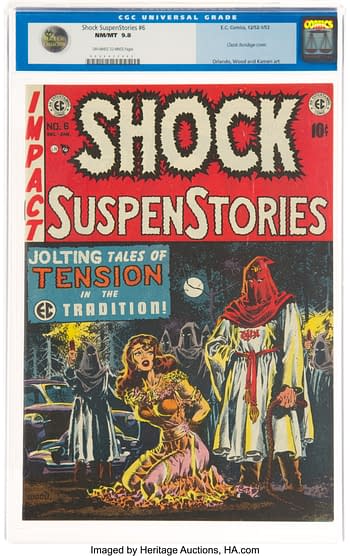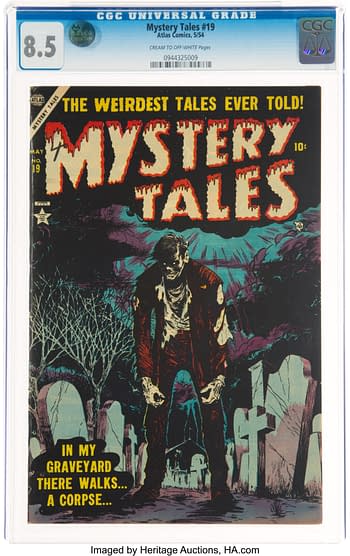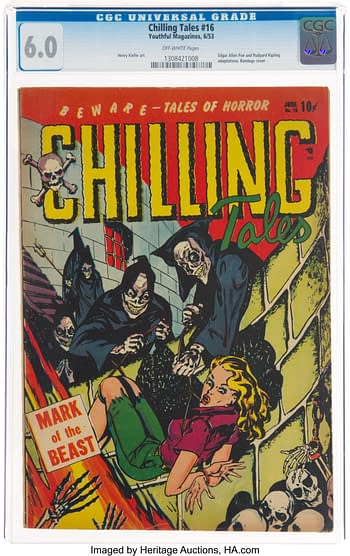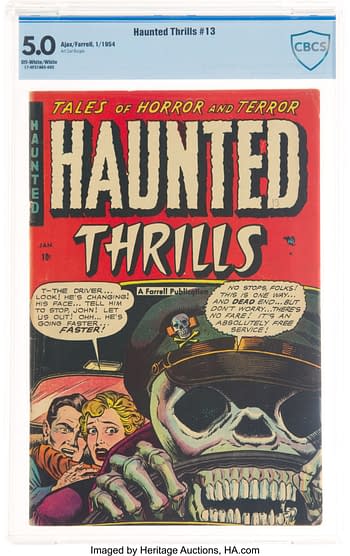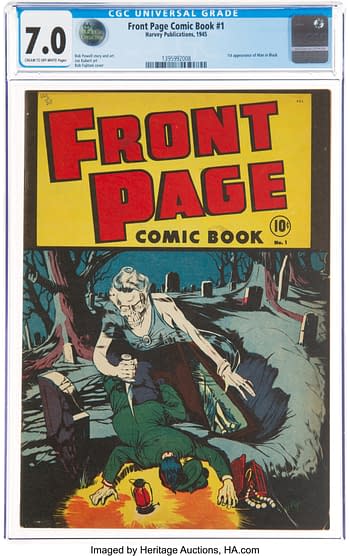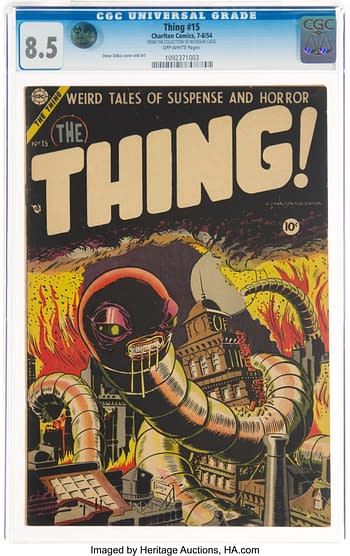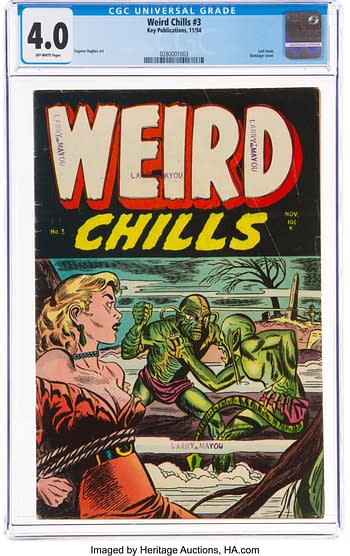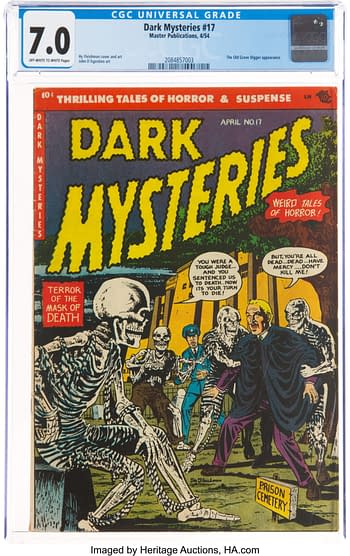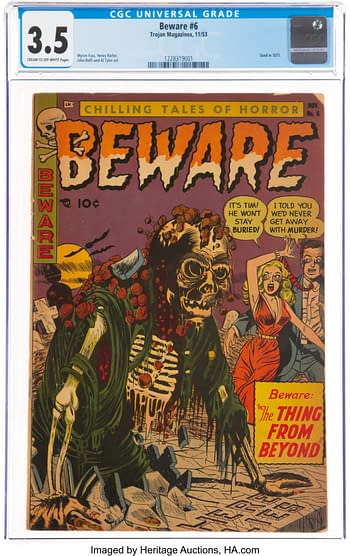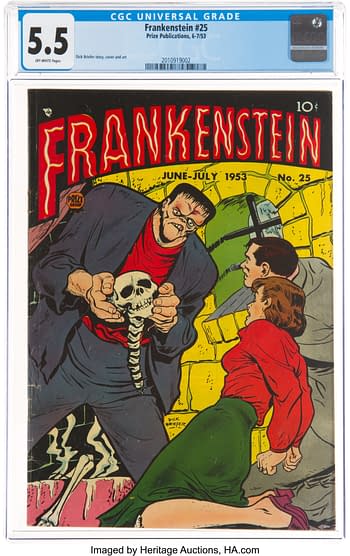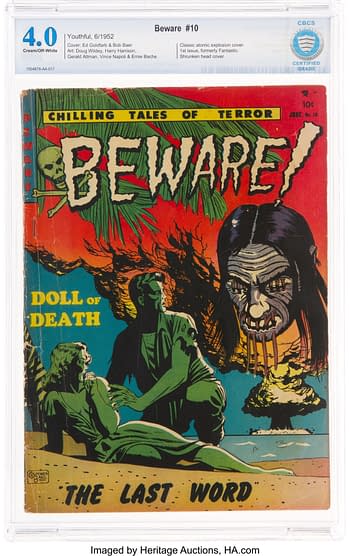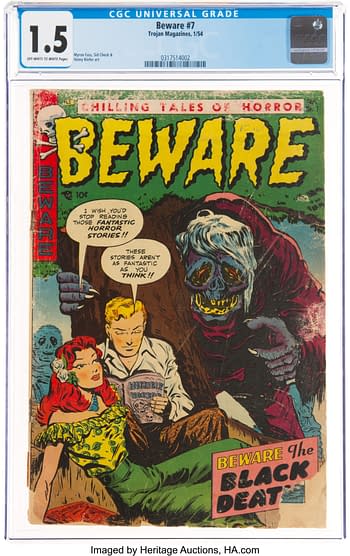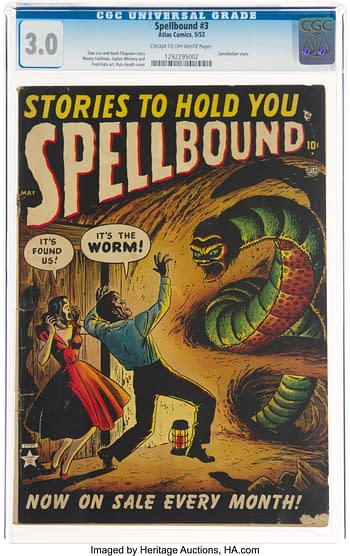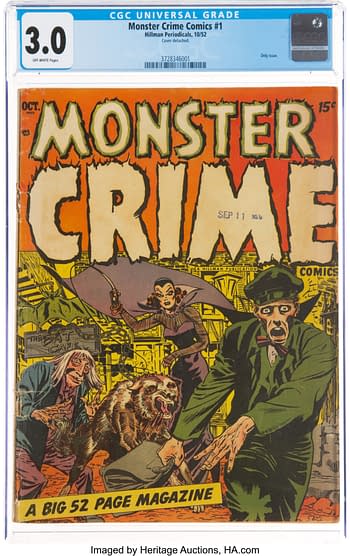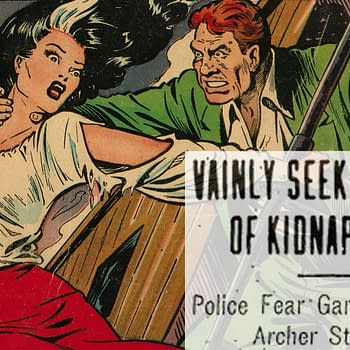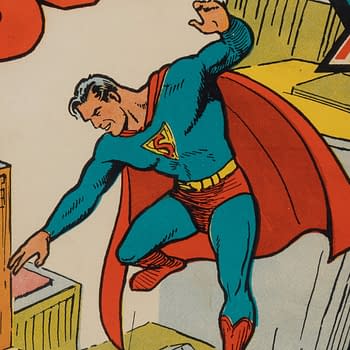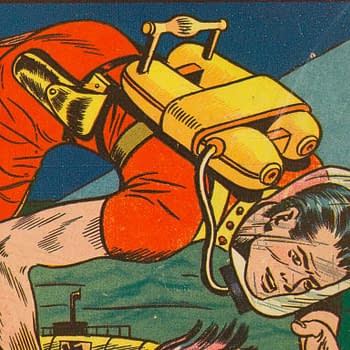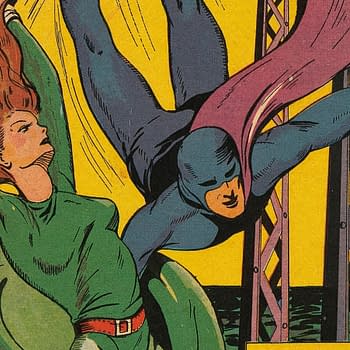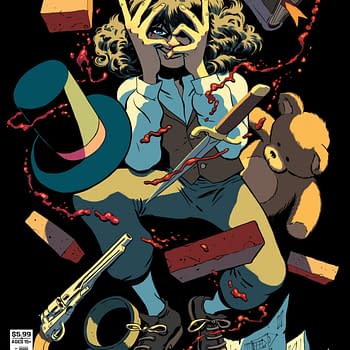Posted in: Comics, Heritage Sponsored, Vintage Paper | Tagged: atlas, ec comics, pre-code horror
A Pre-Code Horror Comic Primer: Lost World of Pre-Comics Code Horror
Over a decade ago, Bleeding Cool ran a "Terrible 25" list of great Pre-Code Horror comics on Halloween. Such lists are fairly common around the end of October every year, but as I said back in 2010, they tend to cover the same unhallowed ground — consisting of lots of EC Comics plus a small handful of other well-known classics. But there's an entire lost world of vintage comics out there which is known to historians as Pre-Code Horror: an unregulated era from the late 40s to the early 50s before the industry was forced to self-censor with the Comics Code Authority. I believe that I first heard the term "Pre-Code Horror" while working at a comic shop in the early 1990s. That period seems to have been close to the early days of vintage collectors as a whole beginning to understand that there was more to comic book horror during the 1950s (and before) than EC Comics. As Lawrence Watt-Evans would aptly put it in 1997:
The accepted wisdom was that Bill Gaines and Al Feldstein, inspired by radio suspense shows like "Lights Out," had invented horror comics out of whole cloth in 1950; that E.C.'s three horror titles had been immediate roaring successes so big that everyone else had slavishly but ineptly imitated them; that the entire censorship flap of the early 1950s, led by Dr. Frederic Wertham, was aimed at E.C.; that the Comics Code, the comics industry's self-censorship mechanism introduced in the fall of 1954, had been specifically designed to kill E.C.
That still seems to be the accepted wisdom.
There's just one problem. It's not true.
- Shock SuspenStories #6 (EC, 1952)
- Mystery Tales #19 (Atlas, 1954)
- Chilling Tales #16 (Youthful Magazines, 1953)
Nearly 25 years after that was written, I'm not sure that accepted wisdom has changed too much. When I was asked to write an introduction to this subject in anticipation of this week's The Black Cat Collection and Pre-Code Horror Showcase Auction at Heritage Auctions, I started browsing through the listings and the challenge became clear — most of these comic books seem very obscure to anyone who is not already a Pre-Code Horror collector or a comic book historian. Let's sort the auction listings by "highest first" and take a look at the items with the top five highest price bids as of this writing:
- Shock SuspenStories #6 (EC, 1952) CGC NM/MT 9.8 Off-white to white pages
- Haunted Thrills #6 (Farrell, 1953) CGC VF/NM 9.0 Off-white pages
- Crime Mysteries #4 Davis Crippen ("D" Copy) Pedigree (Ribage Publishing, 1952) CGC VF+ 8.5 Off-white pages
- Mystery Tales #19 (Atlas, 1954) CGC VF+ 8.5 Cream to off-white pages
- Chilling Tales #16 (Youthful Magazines, 1953) CGC FN 6.0 Off-white pages
This is a live auction, so those rankings are likely to change, but it serves to illustrate the point here: the top item, Shock SuspenStories #6 is not only an issue of an EC Comics title, but it's one of the most famous single issues in EC Comics history, and also one of the most reproduced comic book covers of all time. But as for the rest of the comic books on that list, it's possible that if you're not already a serious Pre-Code Horror collector, you haven't heard of or perhaps even seen any of them before. You may not have even heard of their publishers, aside from Atlas — which many comic fans know was the name that Marvel used in the 1950s.
But understanding and collecting Pre-Code Horror (PCH for short) need not be confined to the already-initiated — and in fact, the notion that PCH is even now still relatively undiscovered country to vintage fandom at large can work to the advantage of the beginning collector. Covers, creators, and concepts of importance to this area of collecting are still evolving today, and doing your homework and getting a feel for the PCH landscape is satisfying and rewarding. For every issue like the infamous Crime SuspenStories #22, which has been well-known and relatively expensive for awhile, there are numerous issues like Venus #18 which have exploded in value over the past decade — if you're lucky enough to find a copy. And there are likely more issues of that nature that will rise to prominence as the market grows and evolves.
- Haunted Thrills #13 (Farrell, 1954)
- Front Page Comic Book #1 (Harvey, 1945)
- The Thing! #15 (Charlton, 1954)
Putting the Pre-Code into PCH
While the beginnings and endpoints of various vintage comic book eras can often be a matter of debate and differing opinions among collectors, the ending of the Pre-Code era is very simple. By definition, the beginning of the Comics Code Authority marks the end of the Pre-Code era. The Comics Magazine Association of America adopted its Code on October 26, 1954, after public campaigns by Fredric Wertham and others against horror, crime, and risque comic books. This moral panic led to televised hearings during which Wertham and comic book industry figures testified before the U.S. Senate. Conforming with Comics Magazine Association of America Code guidelines became a de facto requirement to get distribution to newsdealers in the United States, and comics that received pre-publication approval from Code administrators carried the Comics Code Authority seal on their covers. American horror comic books up to that moment can be PCH, but of course, comics that bear the Code seal cannot be Pre-Code. So for example, Uncanny Tales #28 is Pre-Code Horror, but Uncanny Tales #29 (the first issue of the series to bear the Code seal) is not.
What difference did having the Comics Code Authority approval make? Code approval required strict adherence to a number of guidelines that covered violent, sexual, and lurid content. In the area of horror, such guidelines included:
- Scenes of excessive violence shall be prohibited. Scenes of brutal torture, excessive and unnecessary knife and gunplay, physical agony, gory and gruesome crime shall be eliminated.
- No comic magazine shall use the word horror or terror in its title.
- All scenes of horror, excessive bloodshed, gory or gruesome crimes, depravity, lust, sadism, masochism shall not be permitted.
- All lurid, unsavory, gruesome illustrations shall be eliminated.
- Inclusion of stories dealing with evil shall be used or shall be published only where the intent is to illustrate a moral issue and in no case shall evil be presented alluringly, nor so as to injure the sensibilities of the reader.
- Scenes dealing with, or instruments associated with walking dead, torture, vampires and vampirism, ghouls, cannibalism, and werewolfism are prohibited.
Put simply, while there were still horror comics of a sort published after the advent of the Code, horror titles which lasted from the Pre-Code to the Post-Code era shifted focus from pure, hard-edged horror to fantasy (ACG's Forbidden Worlds, for example) or weird science fiction (Marvel titles such as Journey into Mystery among others). Pre-Code Horror typically has a distinct look and feel vs the comic books that came after it. To put that in perspective, even when the Comics Code Authority guidelines against some aspects of horror were relaxed in 1971, allowing staple horror characters to appear again (Marvel's Morbius the Living Vampire, appearing in Amazing Spider-Man #101, and Werewolf by Night, appearing in Marvel Spotlight #2 are good examples) the overall look and feel of comic book horror still did not approach the extreme edge that it had at the height of the PCH era. And while there are certainly horror comics published in more recent times that have recaptured that type of horror, it's arguable that mainstream comic book horror has never been the same since the PCH period. It was a historically unique time in comic book history.
While the end of the PCH era is easy to define, the beginning of the period is somewhat more elusive. Key early moments in comic book horror history look something like this:
- Prize Comics #7, December 1940 featuring the Frankenstein Monster and the start of a regular feature in the title. While this take on the character eventually became humorous, it started out as a serious attempt at a comic book version of the classic horror monster (and returned to a serious horror character at the peak of the PCH boom).
- Spook Comics #1, 1945 from Baily Publishing Co. Certainly a horror cover, and containing largely humorous but supernatural-oriented content.
- Front Page #1 from Harvey Comics in 1946. Supernatural content, the first story framed by the character the Man in Black.
- Eerie Comics #1, Avon January 1947. Widely considered the first horror-only comic book.
- Adventures into the Unknown #1, Fall 1948, becomes the first successful horror comic book series.
- Amazing Mysteries #32, May 1949. Marvel enters the horror comic business.
- Crime Patrol #15, Dec/Jan 1949/50, EC Comics edges into the horror comic business.
Given the above, it's somewhat difficult to establish a starting point for the PCH period, and this points to how this area of collecting is likely to evolve in the future. While Eerie Comics #1 is widely considered the first horror comic book, it's difficult to exclude Harvey's Front Page #1 from that category — particularly considering the contents of comics that are firmly considered horror such as Adventures into the Unknown. Likewise, Amazing Mysteries #32 is likely much more important than it gets credit for as the start of the boom period of PCH, as Marvel became the driver of the genre with around 389 comics which can be considered PCH, vs EC Comics PCH output of about 91 comic book issues.
Overall, there are over 1400 Pre-Code Horror comic books from over 30 publishers during the PCH period. The Digital Comic Museum has assembled a good list on the subject, which is itself based on a list from the book Four Color Fear: Forgotten Horror Comics of the 1950s. Even with this relatively comprehensive list, there's some room for expansion. The Chesler line includes a number of covers likely to appeal to PCH collectors, like the classic Punch Comics #19. A number of comics featuring covers by the likes of L.B. Cole, Alex Schomburg, and others such as the legendary Suspense Comics #3 are also examples of comics that are not technically PCH, but are likely to appeal to PCH collectors on the strength of the cover alone.
Horror also encroached on the comic books of other genres as well during this period, as publishers sought to take advantage of the PCH trend. For example, Jumbo Comics of this period during the end of its run often featured a horror or supernatural slant. Crime comic books with a horrific slant are also typically sought after by PCH collectors. Fight Against Crime #5, Perfect Crime #30, Who is Next #5, and Crime Does Not Pay #33 are good examples. Notably, publishers sometimes leaned into the crime/horror combo to spectacular effect with comics like Hillman's Monster Crime #1.
- Weird Chills #3 (Key Publications, 1954)
- Mysteries #6 (Superior Comics, 1954)
- Horror From the Tomb #1 (Premier, 1954)
Pre-Code Decoded
Pre-Code Horror comic book collecting is subject to similar motivating forces as any other aspect of vintage comic book collecting. A great cover alone — which in the case of PCH, can often mean lurid, shocking, or just plain scary — can drive demand for a comic book. Work by historically important creators or featuring historically noteworthy characters is also always desirable. But comic books that were singled out by industry critics like Gershon Legman, Fredric Wertham, other authors of prominent anti-comics articles and legislative bodies like the U.S. Senate are also now sought after by PCH collectors because they were mentioned in this context. Perhaps the most famous example of this is EC Comics' Crime Suspenstories #22, which has rocketed to infamy due to EC Comics Publisher William Gaines tensely squaring off against Senator Estes Kefauver to debate the artistic merits of its cover image in front of a Senate Subcommittee and the entire nation in 1954. But there are many other PCH comic books that are deserving of greater attention for their mentions in similar contexts. It's another rich area of historical research and study in the field.
And there are a number of other attributes which can bring a PCH comic book cover to the attention of collectors, for example:
- Dark Mysteries #17 (Master Publications, 1954)
- Beware #6 (Trojan/Prime, 1953)
- Adventures Into Terror #19 (Atlas, 1953)
Skull Covers
A classic symbol of horror and evil that largely disappeared from comic book covers due to the Comics Code. Interestingly, Skull covers are often not necessarily graphically violent or lurid on their own (though of course, they can be), but were sometimes used in cleverly symbolic ways in line with the skull's historic meaning as the universally-understood portent of death, danger, and evil.
- Adventures Into Terror #19 (Atlas, 1953)
- Beware #6 (Trojan/Prime, 1953)
- Dark Mysteries #17 (Master Publications, 1954)
- Dark Mysteries #18 (Master Publications, 1954)
- Eerie #11 (Avon, 1953)
- Haunted Thrills #5 (Farrell, 1953)
- Haunted Thrills #13 (Farrell, 1954)
- Journey Into Fear #20 (Superior Comics, 1954)
- Mysteries #6 (Superior Comics, 1954)
- Mysterious Adventures #13 (Story Comics, 1953)
- Strange Stories from Another World #4 (Fawcett Publications, 1952)
- Weird Terror #2 (Comic Media, 1952)
- Witches Tales #23 File Copy (Harvey, 1954)
- Frankenstein Comics #25 (Prize, 1953)
- Jumbo Comics #161 (Fiction House, 1952)
- Ghost #6 (Fiction House, 1953)
Bondage Covers
Bondage imagery came to the attention of vintage collectors due to the assertion by Legman, Wertham, and others that depictions of women in restraints were symbolic of sadism or sexual torture. While typical damsel in distress imagery on these covers can certainly be risque and imply such elements, this aspect of vintage collecting largely seems to be an example of the Streisand Effect — people want to see it because it was forbidden.
- Chilling Tales #16 (Youthful Magazines, 1953)
- Frankenstein Comics #25 (Prize, 1953)
- Ghost #6 (Fiction House, 1953)
- Jumbo Comics #161 (Fiction House, 1952)
- Red Seal Comics #14 (Chesler, 1945)
- Strange Terrors #6 (St. John, 1953)
- Weird Chills #3 (Key Publications, 1954)
- Witches Tales #8 (Harvey, 1952)
- Beware #10 (Youthful Magazines, 1952)
- Clutching Hand #1 (ACG, 1954)
- Beware #7 (Trojan/Prime, 1954)
Lurking Dread
Interestingly, not all PCH covers — and perhaps not even the majority of PCH covers — contain gruesome imagery or explicit violence. Despite what the critics implied, many such covers were about setting up the lurking terror to come and did so quite effectively.
- Beware #10 (Youthful Magazines, 1952)
- Beware #7 (Trojan/Prime, 1954)
- Beware 16 (#4) (Trojan/Prime, 1953)
- Clutching Hand #1 (ACG, 1954)
- Dark Mysteries #11 (Master Publications, 1953)
- Ghost #2 (Fiction House, 1952)
- Ghost #10 (Fiction House, 1954)
- Haunted Thrills #4 (Farrell, 1952)
- Haunted Thrills #17 (Farrell, 1954)
- Horror From the Tomb #1 (Premier, 1954)
- Punch Comics #19 (Chesler, 1946)
- Wanted Comics #52 (Orbit, 1953)
- Spellbound #3 (Atlas, 1952)
- Web of Mystery #7 (Ace, 1952)
- Monster Crime Comics #1 (Hillman Publications, 1952)
The Collectibility and Rarity of PCH
Pre-Code Horror comics are generally rarer than their superhero counterparts from the Golden and Silver Ages — and much tougher to get in high grade. With few exceptions, publishers during this period were chasing declining market share by publishing more and more titles. The industry was putting out nearly triple the number of comic books in 1952 as it did in 1945 — and most publishers were still facing declining circulation. This almost certainly pushed some established publishers to cut corners on paper and printing quality as well, while distribution became a challenge due to numerous local officials attempting to enact legislation against the sale of such comics. Of course, the public anti-comics campaign that raged against the industry during this period had parents on heightened alert to throw out their kids' comic books, not to mention the highly-publicized comic book burnings staged around the country. It's almost certain that fewer PCH comic books were saved by collectors, and there are fewer pedigree collections containing significant PCH runs vs the number of Golden Age and Silver Age pedigrees (the Northford pedigree being perhaps the most noteworthy pedigree containing PCH comic books). Even among the PCH comic books that have survived, high grades are often far less common due to the prevalence of the horror-themed cover art with black or otherwise darkly-covered backgrounds which tend to show wear more easily.
But the bottom line is this: EC Comics have been widely collected by comics fandom since the late 1960s, as have Golden Age and Silver Age comic books. As for these other PCH issues… not so much. The vast majority of the output of the PCH period spent perhaps an additional 30 years being overlooked — and perhaps even destroyed. Even now, the best part of getting into PCH comic book collecting is the satisfaction of learning, understanding, and preserving this nearly-forgotten moment of comic book history.



